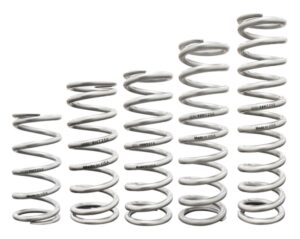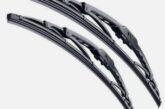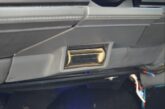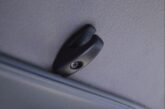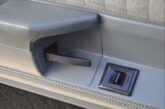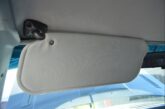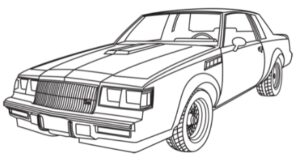Unless you have access to scaling the corner weight of your Turbo Regal, or some other way to get your vehicles actual weight, you’re mostly left with guestimating which springs you should choose.
Shock manufacturers (or the vendors you’re buying them from) can give you an educated recommendation if you contact them, but even that’s pretty much a guess (albeit probably a closer estimation than your own).
Most people just take a look at what other Buick Regal owners have used, and choose a similar path.
That’s what we did, initially, for the 1987 Buick Regal Grand National.
This Coilover Spring story will be a 3-part series.
1. introduction to choosing the right spring selection. (THIS article)
2. A how to on changing the front springs. (tomorrow)
3. A how to on changing the rear springs. (day after tomorrow)
.
.
When we installed the front coilovers on a Buick Grand National, most other identical cars were using 450 pound springs, so those are the ones we went with.
The springs seemed ok at first, although we positioned them a little bit higher up on the shock body, since this particular G-body Regal has 28″ tall tires in the front (as opposed to the stock 26″ tire height) and this (additional raising) aided to make sure the tires didn’t hit the wheel wells (or the GNX fender flares).
In general (for all around street driven / occasional track use / etc.) Turbo Buick vehicles usually accommodate 350-550 lb springs for the front end, depending on what motor is in the car (original or v8 swapped), and/or if anything else has been added (FMIC, etc.), or deleted/changed (battery relocation, fiberglass replacements, etc.).
(different shock/spring manufacturers recommend different rate springs. For instance, the Ridetech brand supplies 800 lb springs for front stock arms! UMI QA1 & most others recommend 450 pound springs. Big differences! Just something to think about…)
We figured that since this Buick GN has a fiberglass hood as well as fiberglass bumpers (along with aluminum bumper shocks, etc., etc.), that the 450 coil springs would be ok, and probably actually a little stiff considering those facts alone.
(most front coilover “kits” do come with the 450lb springs)
(just FYI, the factory HD springs are rated at 420 lb)
(another hmmm to think about: OEM stock G-bodies get 420 pound springs, F-body cars get 700 pound springs, even though they weigh less! Perhaps that’s because they are suppose to be more “performance” orientated?!)
The passenger side coilover spring was adjusted higher up (on the shock body) than the drivers side (approx 1/2″ more), as it would scrape on big bumps/dips in the road.
(and surprisingly, the fender height remained relatively level on both sides, even with this adjustment)
(note that some coilover users have stated that indeed, coilovers give a somewhat bouncy type ride, compared to the “floating” type ride that stock springs provide. We don’t like the way it rides however, so we are intending to change it via stiffer springs, since adjusting the shocks themselves would not provide the type of ride that we are seeking)
For the rear coilovers on a Buick Grand National, we used 150lb springs, based on the same logic as the front setup.
Most Turbo Buicks have 110-225 pound springs to keep the car in balance.
(most rear coilover “kits” come with the 150 lb springs)
Once in a while driving down the road, the Buick GN felt like it was bouncing (not a lot, but some), sort of like the feeling you get when the springs or shocks are bad in the car, and the body goes up and down until it finally settles.
We anticipated (months after the initial installs) that eventually we’d need to investigate this further sometime in the future, and would most likely have to change out the springs to something different to cure this issue. The bouncing issue wasn’t an all the time problem, so we didn’t need to rush onto figuring it out.
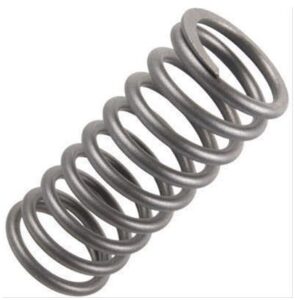 We hadn’t intended on addressing this concern yet, but while browsing Facebook one day, a fellow BTR owner was selling a pair of 550lb front coil springs (for the same Viking shocks we’re running), for what we deemed a decent price (new springs are $65 each + shipping, this used set was $75 shipped for both), so we took a chance on acquiring them.
We hadn’t intended on addressing this concern yet, but while browsing Facebook one day, a fellow BTR owner was selling a pair of 550lb front coil springs (for the same Viking shocks we’re running), for what we deemed a decent price (new springs are $65 each + shipping, this used set was $75 shipped for both), so we took a chance on acquiring them.
Again, this was a total guess that this would solve part of the bouncy issue (since shock adjustments on the double adjustable setup weren’t completely helping, although they made it somewhat better when we clicked the dials up). We figured stiffer springs certainly wouldn’t hurt in this area, so we went for it.
The previous owner (of the springs) switched from these 550lb units to 450 pounders, and claimed that for his specific application (another ’87 GN) the only thing different he noticed between the 2 springs was that the overall ride height dropped about 1/2″ (with the 450’s) but ride quality remained about the same. Our logic kicked in, and figured that reverse engineering would apply towards our 1987 Buick GN and it would raise our height by the same amount (which would benefit our tires from smashing into the wheelwells, and probably stiffen things a bit up too, while also being able to lower the bottom position of the spring on the shock body some as well, while keeping the same amount of pressure, or a bit more, on the frame).
They always say you should only do 1 modification at a time so you can accurately measure the results.
Well, our educated guess believed that the bouncing issue was mainly caused by the rear setup moreso than the front, but since we got a good deal on front springs, we changed those out as well, and did both front and rear at the same time.
Doing some research on Youtube, to see recommendations on what others have used, what the experts and manufacturers of rear springs have to say about the entire issue, and which springs you should choose, and why, revealed some theories on selection of said items.
The majority of Buick Regal Grand National owners, are, in fact, using 150 lb (coilover) springs for the rear.
(but whether or not the 150s are the correct choice or not though, is debatable)
The 150 pounders are what we put on ours from the get-go.
However, we did add in a custom subwoofer box and trunk carpet kit, which adds approximately 100+ pounds (maybe more?) onto the rear section of this G-body vehicle (compared to the OEM setup).
One (race car chassis) vendor we spoke with, said that most of the Turbo Buicks he has set up with a sub box in the trunk are indeed using 250 pound springs.
——
One of the videos we watched explained a formula for figuring out correct spring weight for the rear.
You must be able to actually measure how much pressure is on your existing springs, with them installed in the car, with a full load on them, for this formula to work.
Meaning you measure how tall the springs are as installed in the car with full weight on them.
THE FORMULA (for rear springs):
– existing 150lb springs, 12″ tall unsprung (free length)
– under load: measure height, example= 10″ compressed (under load), = 2″ squat (12″ minus 10″)
– 2″ squat x 150 = 300lb load on springs
– so 300 = should be correct spring weight for the vehicle
– 300 / 2 (springs) = 150lb springs (each)
APPLYING THE FORMULA TO OUR 1987 BUICK GN:
– our existing 150lb springs, 12″ tall unsprung (free length)
– under load: measures 8.5″ tall, so squat = 3.5″
– 3.50″ x 150 = 525lb load on springs
– so 525 = the correct spring weight for the vehicle
– 525 / 2 (springs) = 262.50 springs we should be using (so either 250 or 275, rounded down/up)
The position of our existing (12″) springs on the rear shock body is rather high (a bit more than 1/2 way up).
When we opt for new springs, since we have to get new ones anyways, we are going to get them in the 14″ tall versions, so that this shock body position can be lowered down (by 2″ – the difference from the 14″ to 12″ spring).
The pound spec of a spring is the same on a 14″ as it is on a 12″ spring, the only difference being the height of the spring.
(so a 150lb 12″ spring is the exact same as a 150lb 14″ spring, the only difference between the two is the actual height of the spring, which is 2″)
OK, so, they say if your numbers (from formula above) fall between 2 different available spring pounds, as ours did, you could go either way depending on the use of your car (more poundage = stiffer), so given our case, we wanted to round up (in an effort to cure the bouncing). That means we should be using 275lb springs.
(but, the 275 pound springs are a special order item. Given the current delay on just about everything, we opted to just search for the much more commonly used 250 pound springs)
HOWEVER, before we’re totally convinced on the 275/250 figure for the rear springs, we saw the 2 things mentioned below!
There is another formula we found, specifically for coilovers, (shown below), that should be considered as well.
(which by the way, mostly contradicts the above formula, lol)
.
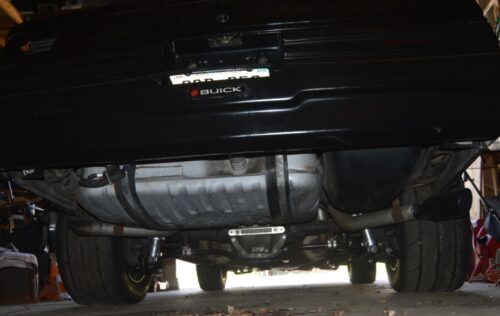
——
The QA1 spring rate chart shows the average rear weight of a gbody is about 1550 lbs (“GM Average Muscle Car Weight” ).
(and we believe the rear end weight on our Buick GN is probably a bit heavier than average)
QA1 says to use:
170 lb for soft ride
200 for medium
220 for firm
So in this instance, we should probably get the 220s, knowing that their rating of “firm” will most likely NOT be that firm for our car (based on weight).
——
The other formula we saw:
FORMULA (for rear springs):
(again, assuming 3600 lb total weight of car)
3600 lb x 42.5% (approx rear weight distribution) = 1530 lb in rear of car
1530 / 2 = 765 lb each side of car (corner weight)
765 / 2 (inches compressed, ideally) = 382.50 lb springs should be used.
(it DIDN’T state the following in the this formula, but we are wondering if it was missed added onto the above should be: 382.50 / 2 springs = 191.25)
So in our case, we should round up and get a 400 lb spring (or maybe 200 lb for the missed added on part?).
Now go figure this, if we should be using 400 (or even 200) pound springs, it’s actually crazy if you think about it, considering that most coilover “kits” come with 150 lb springs! (that are suppose to be about the correct ones to use ON most Turbo Buicks!?)
(not to mention that most Turbo Regal owners ARE using 150 pounders!)
(maybe less spring rate than should be required gives a MUCH softer ride? Or better off the line performance? But, are they strong enough to actually hold the car up? and the longevity of them?)
Are you confused yet? You should be! There’s so much confusion when trying to figure out correct spring rates!
(to be fair, most owners install the recommended 150 pounders and are happy with them)
(but, in our case, we are not, since we have that “bouncy” issue happening)
.
During our research about rear springs, to add to the mess of trying to figure out proper springs, here’s what one fellow Turbo Regal owner says he’s using:
I experimented and had Kevin from Baseline suspensions helping me here’s what I found / I am working on weight transfer / launch kinda set up – on my corner scales I have the car at 54.55% front and 45.45% rear.
14″ 150lb HT – too stiff
14″ 95 lb HT – too soft, car rode like a tank, binding
14″ 110 lb HT – just right, you can adjust the ride quality (thru the shock settings), happy with them
(granted, this guy is trying to max out his launch efforts, and isn’t concerned with how the car drives on the street, so factor that in when reading his results)
.
—————-
For the same type of formula as the one directly above, but for the front:
FRONT SPRINGS:
We found a formula online for figuring out what should be used for front springs:
(A guesstimation of this particular G-body Regals weight is 3600 pounds, even with all the FG components; they say stock weight is about 3450 which we think is actually low, based on what others have actually weighed out at.)
FORMULA (for front springs):
For front end springs, the formula, assuming you know the weight of your front end, is:
(example below assumes 12″ springs) – (3600 lb x 57.5% front distribution = 2070 lb front end weight)
(and the 2070 figure is close enough for this example; we know that we have a FG bumper & hood which takes some of the weight off the front, and added a sub box in the back, which added some weight)
– 2070 lb front end weight (example)
– divide by 2 since there’s 2 springs on the front end (so 1035 lb for each side of car; corner weight)
– you want it to compress 2″ (with weight of car on springs), so again, divide by 2
– result: 517.50 lb springs
So, in our case, the 550 lb spring should be adequate enough to hold up the front end of the Buick GN.
.

——
We already have the 550 lb spring for the front (from the deal we scored).
New Viking rear coilover springs are available in ranges 95-350 pounds (in 25 lb increments), and are about $45 each (+ shipping), if you want to special order them.
(some vendors have certain ones already in stock, so ask before you buy! You don’t want to be waiting months for them to arrive…)
We were all ready to order a set of brand new 14″ 250lb springs considering that for all of the formulas, this number seems to be a good compromise for all of them averaged.
But before we actually pulled the trigger, we found a “slightly used” (supposedly mounted only, for fitment purposes, but not actually “used” as in driven on) set of 14″ 250lb springs (ebay, $80 shipped) and within a week they showed up at our door.
(and they look good, as stated)
.
Since we installed the UMI competition style tubular a-arms on the front of the Buick Grand National, swapping out coil springs and shocks is (suppose to be) made easy by just removing the double shear bars on the lower arm.
(tomorrow’s post will show you this in detail)
.
The rears required the entire coil overs (shocks, springs) to be removed, to reinstall the new coil springs. Attached at the top of the shock mount (above the frame/chassis mount) is the shock tower brace, so that needed to be temporarily detached as well.
(the day after tomorrow’s post will show you the steps for this)
.
Thanks for following along.
See you tomorrow!
.


















